Quiz Answer Key and Fun Facts
1. This breed of dog is about the size of a German Shepherd, with the black and tan markings of a Rottweiler or a Doberman Pinscher. It is recognizable by its double dewclaws. What is its name?
2. This black and white dog with a spitz-like appearance (pointed ears and curled tail) was developed in Finland for big game hunting. Which of these is being described?
3. There are four breeds of the Belgian Shepherd dogs. Three of them are common enough in America to be recognized by the AKC. These are the Belgian Sheepdog (Groenendael), the Belgian Tervuren, and the Belgian Malinois. The fourth, the Belgian _____, is still considered a rare breed in America. What is the missing word in its name?
4. This dog was created after the Second World War by using a mixture of breeds that included Rottweilers, Giant Schnauzers, Great Danes and Airedale Terriers. The goal was to create a rugged, all-purpose terrier who could survive harsh winters. Which of these breeds is in the picture?
5. This dog was developed in Mexico, before the time of the Aztecs, and is best known for his lack of hair. Unlike the Chinese Crested dog, which is also called hairless but has long tufts of hair on the head and legs, this dog only has small traces of hair on the top of his head. Which breed is it?
6. This large dog, usually of a grayish color, is characterized by its great masses of skin, especially around the head and the dewlap. It is speculated that he may be related to the ancient Roman breed, the 'Molossian', which was an aggressive dog used in wars. What breed has just been described?
7. This is a medium sized dog, but incredibly tough. Bred to be a sheepdog, these dogs can work for hours without tiring. They often have to work by themselves, relying on their own wits and brains to handle the stock. What is their name?
8. This amazing dog was originally created around the 1500s to hunt puffins in the tiny caves along the cliffs. Amazingly flexible, he can bend his head entirely backwards, touching the top of his head to his back. He also has at least six toes on each foot, and has the ability to close his ears to keep water out. Whose paw is in the picture?
9. There are four types of setters, three of which are the Irish setter, the English setter and the Gordon setter. What is the fourth setter?
10. This coonhound is descended mainly from English foxhounds and French dogs, such as the Grand Bleu de Gascogne. He is known for his 'cold nose', or the ability to follow old trails in the pursuit of raccoons. Which type of coonhound is this?
11. The ancestors of this breed came from the boar hunting dogs of Germany, when their owner moved to America. Settling in North Carolina, he used his dogs to hunt bears. What did he call them?
12. This medium sized dog had the unique job of prancing and playing on the shorelines, sometimes disappearing and then quickly reappearing into view. These actions roused the curiosity of the waterfowl, who came to investigate this strange sight. The dog's master shot them when they were in gun range, and the dog would retrieve them. Who is this playful puppy?
13. This large dog was developed from the Newfoundland, St. Bernard, Great Pyrenees and Greater Swiss mountain dog, among others. Mayor Heinrich Essig claimed that he created the dog in the 1840s to look like the lion that was on his city's crest. Which of these dogs is now a tawny lion color, sporting a mane?
14. This is a sighthound, resembling the greyhound in some respects. Bred in North Africa over many centuries, this ancient breed once hunted everything from desert hare to gazelle to hyena to ostrich. Which of these dogs is now known as a hunter and a protector of herds?
15. This "barkless" dog resembles the dingo. It can make a good pet, but it is still partly a wild dog. Whose most distinct feature is their melodious voice?
16. This dog is one of the oldest American breeds, developed in the 1700s for hunting deer and 'herding' the wild and dangerous cattle and pigs. He is well known for his mottled coat, and often one or both eyes will be blue. Who is in the picture?
17. This dog is also known as the French mastiff. He is orange in color, and has the largest head of any dog. He is probably descended from the dogs that accompanied Roman and Macedonian armies throughout their marches. He was later used as a bullfighting dog for the amusement of people at circuses. What breed is this?
18. Similar to the Maltese and Bichon Frise, this dog is a small, white companion dog. This small dog was once a popular court dog in Italy. What is the name of this ball of fluff?
19. This Hungarian breed was descended from the puli, but lost its distinct corded coat when outbred to other dogs, including German Pomeranians, French briards, and several varieties of terriers. He was originally bred for herding cattle. What breed is pictured here?
20. This American terrier is descended from many imported terriers as well as whippets, Italian greyhounds and beagles. Sometimes known as feists, they were popularized by President Teddy Roosevelt. There is also a hairless variety that appeared in a litter in 1972. What type of terrier is this?
Source: Author
looney_tunes
This quiz was reviewed by FunTrivia editor
rossian before going online.
Any errors found in FunTrivia content are routinely corrected through our feedback system.
